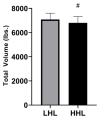Effects of Varying Load Intensity on Skeletal Muscle Damage Between Two Isovolumic Resistance Exercise Bouts
- PMID: 36620189
- PMCID: PMC9799231
- DOI: 10.70252/HXMP5676
Effects of Varying Load Intensity on Skeletal Muscle Damage Between Two Isovolumic Resistance Exercise Bouts
Abstract
There are limited data comparing the efficacy of resistance loads within the hypertrophy range for promoting muscular growth, particularly when similar training volumes are utilized. The purpose of this study was to determine if two similar volume-loads, utilizing different intensities, would produce dissimilar muscular damage and inflammation. Eleven resistance-trained, college-aged males participated in this study. After testing 1RM barbell squats, participants completed two similar volume-load barbell squat sessions at two different resistance loads (67% and 85% of 1RM) on two separate visits. Venous blood samples were collected at baseline and one hour after completion of each exercise session. Plasma was isolated and analyzed for myoglobin and C-reactive protein (CRP) expression via ELISA. Plasma myoglobin expression was significantly elevated above baseline (BASE) values only after the 85% of 1RM (HHL) session (p =0.031), though the 67% (LHL) trial (p = 0.054; η2 = 0.647) was approaching significance (BASE: 1.42±.12 ng/mL; LHL: 4.65±1.13 ng/mL; HHL: 5.00±1.01 ng/mL). No changes in plasma CRP were observed. Despite attempts to equate volumes between resistances, mean total volume-load was significantly higher during the 67% of 1RM trial than during the 85% trial. Resistance loads at 85% of 1RM inflict significantly increased muscle damage over baseline values, even when significantly less total volume was lifted during the 85% trial. Individuals looking to maximize strength and hypertrophy during general training or during rehabilitation may benefit from these findings when determining the appropriate training load.
Keywords: Resistance training; hypertrophy; inflammation; muscle damage; volume-matched.
Figures



Similar articles
-
Blood Flow Restriction at High Resistance Loads Increases the Rate of Muscular Fatigue, but Does Not Increase Plasma Markers of Myotrauma or Inflammation.J Strength Cond Res. 2020 Sep;34(9):2419-2426. doi: 10.1519/JSC.0000000000003742. J Strength Cond Res. 2020. PMID: 32740287
-
Acute cellular and molecular responses and chronic adaptations to low-load blood flow restriction and high-load resistance exercise in trained individuals.J Appl Physiol (1985). 2021 Dec 1;131(6):1731-1749. doi: 10.1152/japplphysiol.00464.2021. Epub 2021 Sep 23. J Appl Physiol (1985). 2021. PMID: 34554017
-
Are Trainees Lifting Heavy Enough? Self-Selected Loads in Resistance Exercise: A Scoping Review and Exploratory Meta-analysis.Sports Med. 2022 Dec;52(12):2909-2923. doi: 10.1007/s40279-022-01717-9. Epub 2022 Jul 5. Sports Med. 2022. PMID: 35790622
-
Effect of external load on muscle activation during the barbell back squat.Eur J Sport Sci. 2023 Jun;23(6):975-982. doi: 10.1080/17461391.2022.2081093. Epub 2022 Jun 13. Eur J Sport Sci. 2023. PMID: 35603722
-
Effects of Periodization on Strength and Muscle Hypertrophy in Volume-Equated Resistance Training Programs: A Systematic Review and Meta-analysis.Sports Med. 2022 Jul;52(7):1647-1666. doi: 10.1007/s40279-021-01636-1. Epub 2022 Jan 19. Sports Med. 2022. PMID: 35044672
Cited by
-
Acute Responses to High-Intensity Back Squats with Bilateral Blood Flow Restriction.Int J Environ Res Public Health. 2023 Feb 17;20(4):3555. doi: 10.3390/ijerph20043555. Int J Environ Res Public Health. 2023. PMID: 36834246 Free PMC article. Clinical Trial.
References
-
- American college of sports medicine position stand. Progression models in resistance training for healthy adults. Med Sci Sports Exerc. 2009;41(3):687–708. - PubMed
-
- Campos GE, Luecke TJ, Wendeln HK, Toma K, Hagerman FC, Murray TF, Ragg KE, Ratamess NA, Kraemer WJ, Staron RS. Muscular adaptations in response to three different resistance-training regimens: Specificity of repetition maximum training zones. Eur J Appl Physiol. 2002;88(1):50–60. - PubMed
-
- Damas F, Phillips SM, Libardi CA, Vechin FC, Lixandrao ME, Jannig PR, Costa LA, Bacurau AV, Snijders T, Parise G. Resistance training-induced changes in integrated myofibrillar protein synthesis are related to hypertrophy only after attenuation of muscle damage. J Physiol. 2016;594(18):5209–5222. - PMC - PubMed
-
- Eftestol E, Egner IM, Lunde IG, Ellefsen S, Andersen T, Sjaland C, Gundersen K, Bruusgaard JC. Increased hypertrophic response with increased mechanical load in skeletal muscles receiving identical activity patterns. Am J Physiol Cell Physiol. 2016;311(4):C616–C629. - PubMed
LinkOut - more resources
Full Text Sources
Research Materials
Miscellaneous
